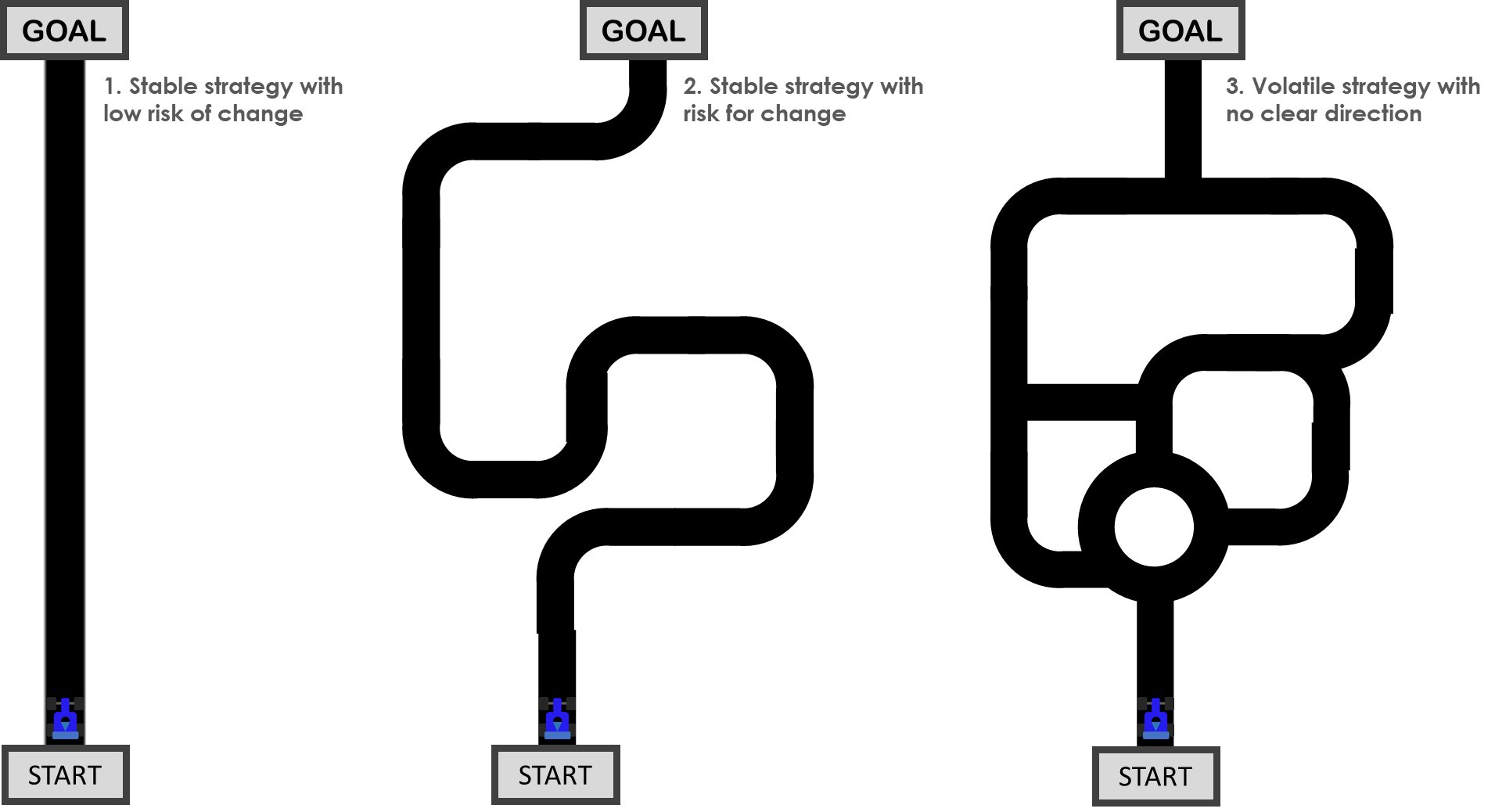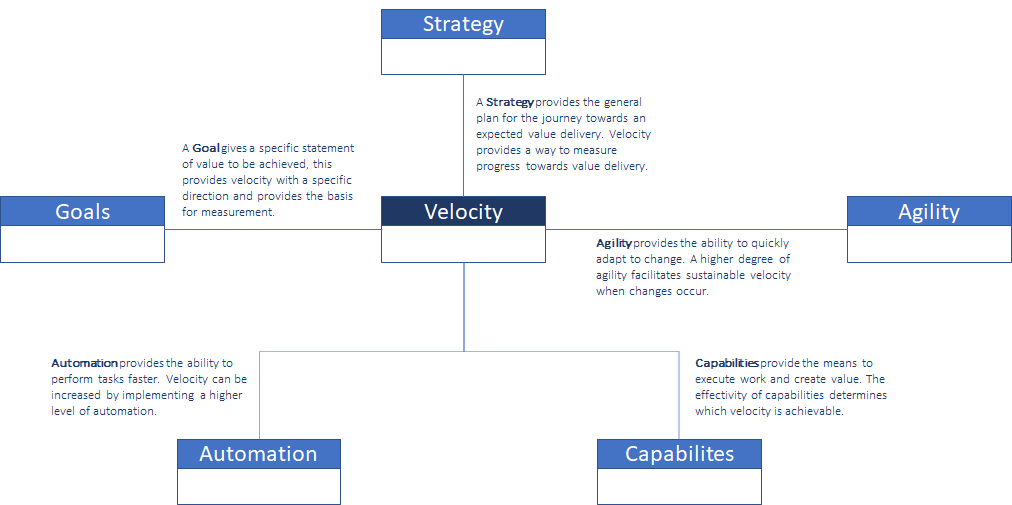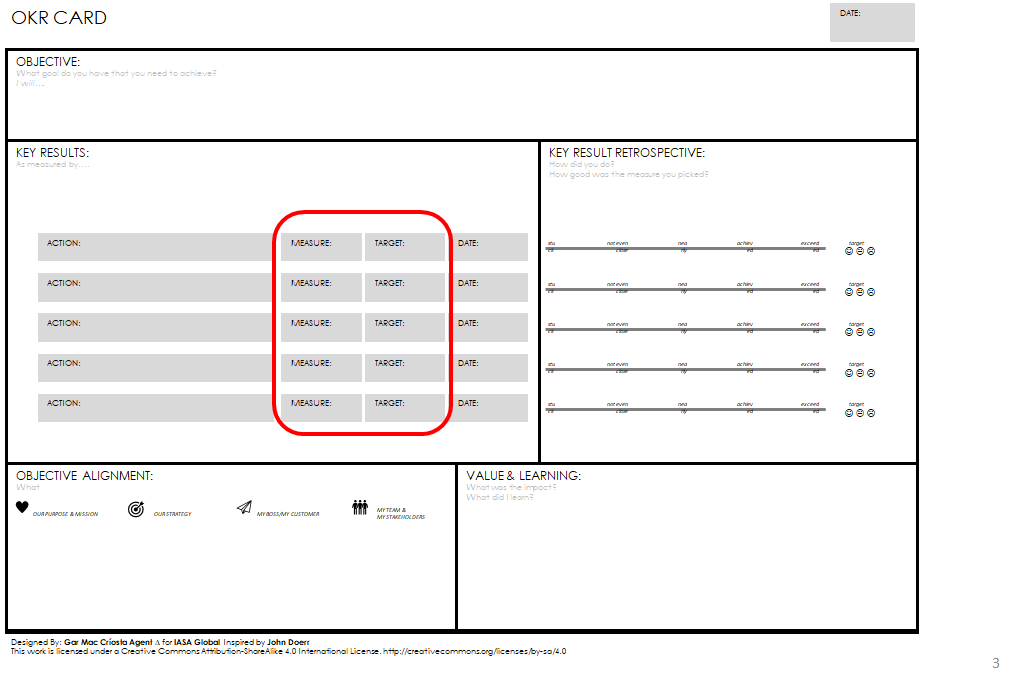“The speed of something in a given direction.” Oxford Dictionary,definition of Velocity.
What is Velocity
Within business the term velocity is often used to describe the rate at which work can be performed. However, it is often missed that velocity also requires two other vital attributes, time and direction. Without these attributes the business only has a measurement of speed, this is not very useful as it does not give an indication of whether the business is making progress against its aims, only that it is able to perform work fast.
In order for a business to measure velocity a direction has to be specified, and a time period given for the measurement. The definition of direction in the case of a business is the value the business wants to deliver. This is important since it means that we can only increase our velocity if we are delivering value at a higher rate.
Using this definition, we can express velocity in business terms as:
“The rate at which a business delivers value over a fixed period of time.”
Value can be expressed in a number of ways depending on the context of what is to be achieved. In order for velocity to be a valuable measure, a statement of value delivery needs to accompany a description of how we measure velocity, this is most often expressed as a goal. For example:
-
Goal: Complete the Release 1.6 of Product X by Q2 2022 Velocity measured by: Number of completed features per month
-
Goal: Increase EU market share by 2 % by 2022 Velocity measured by: Number of new customers gained every month minus customer attrition
-
Goal: Increase customer support satisfaction by 5% before Q3 2021 Velocity measured by: Number of customer support issues solved with satisfied customers on a weekly basis
Note that the value delivery is often expressed as a goal and the measurement for velocity is similar to a KPI (Key Performance Indicator).
Why is Velocity important
Velocity is important as a measure, as it allows a business to plan for a given activity, and to measure progress during execution of the activity.
The velocity of the business will determine how fast the business can deliver value and can be used as a measure against competitors. A business with high velocity will be delivering value at a fast rate, and this in turn, means the business will achieve a faster return on investment (ROI).
Velocity can be used as an important planning tool. Using a given goal, the business can work out the required velocity needed in order to deliver the value on time. This can be used as a benchmark during execution to assess if the expected delivery is on time or even feasible. Velocity can also be used to measure how effective a value stream is by measuring the rate of value delivery.
Using velocity as a measurement allows the business to continuously monitor progress of value delivery. If the business is not achieving the desired velocity, action can be taken to increase velocity and ensure that the value is delivered on time, or delivery deadlines can be adjusted.
Velocity Approach
Value delivery is key
When defining and measuring velocity the goal for value delivery is key, this provides direction. An unclear goal is likely to have a negative effect on velocity, the business may be able to achieve a high rate of delivery but it may not be delivering value. In the worst case where a goal does not exist, velocity cannot be measured. Without a goal, a measurement can only be made for how fast something is being delivered, but it cannot be known if the delivery provides value or not.
Planning velocity
Velocity is often used as a measurement but it may also be used as a planning tool. For example, when defining a goal, the business can assess the velocity required to achieve delivery on time. Then working from the required velocity, the business can then assess if they have the capability to achieve that velocity. This allows the business to determine if the value delivery is realistic before making significant initial investments.
Understand business capability and value streams
It is important to understand the capability of the business in relation to velocity. When planning for business velocity the limitations of the business capabilities have to be understood in order to set realistic velocity targets for value streams. Otherwise, the business may consistently miss delivery targets for value streams which can lead to loss of motivation. Even if velocity is used primarily as a measurement it is important to understand how the business capabilities affect the measurement, and how improving capabilities can improve velocity within a value stream.
Architecture facilitates
When developing an architecture, significant consideration should be given to velocity requirements. Understanding the business needs for velocity, aids the architect in making architecturally significant decisions, this ultimately facilitate business velocity.
Planning Velocity
Planning velocity starts with a goal that the business wants to achieve to deliver value. These are often defined, for example, during work with the business strategy or at the planning stages of product development.
Planning velocity is really about defining a benchmark or target velocity which is required to meet value delivery. When planning a target velocity, the business will have to consider a number of factors to ensure that the target velocity is realistic:
-
Resources - does the business have the people and finances needed to meet the velocity
-
Technology – does the business have the tools and support needed to meet the velocity
-
Processes – does the business have the processes in place which are needed to meet the velocity
In short, does the business have the capabilities in place which are required to meet the velocity.
If the business finds that the capabilities are not sufficient, the business can choose to increase its capabilities, lengthen the delivery deadline (lower the velocity), or reduce the value delivery expectations.
A practical example of planning velocity is shown in the OKR card below.
It can be seen in the OKR card above, that for each Key Result in the card there is a field for measurement, and a field for target. Depending on the type of key result, velocity can be used as a target and a measurement.
Velocity as a measure
Velocity is measure to ensure that value is being delivered at a rate which the business determines achievable. Before velocity can be measured, the business must determine the units of measurement. This very much depends on the context of the value delivery, the following are examples of two contexts for measuring velocity.
Product development context
A business may have a goal to deliver a new product release within 6 months. The release specification of the product features provides a description of what is to be delivered. The value for the product owner of the development team is to deliver these features before the 6-month deadline, where delivery of the release will provide value to the customer. The development team use agile methods to provide a delivery of a specified set of features every three weeks.
This would mean that we can define a useful measurement of velocity in the following way:
“The number of completed features as specified in the release specification every three weeks.”
The important thing to notice here, is that the velocity is dependent on “the completed features in the release specification”, as it links directly to expected value delivery. In this context, work items during development such as, re-work, refactoring or bug fixes, will not contribute to velocity. Only completed features are measured, since that is the measure of value.
Business strategy context
A business may want to increase its market share for certain services within a particular country, for example, sci-fi film streaming services in Sweden. The business currently has a 1% market share in Sweden, it wants to increase that share to 5% within one year. In order to execute this strategy, the business decides to run an advertising campaign every month for sci-fi films. The CEO of the company expects the increase in market share to be shown by the number of unique customers which are subscribed to the service.
A useful definition of velocity in this context may be:
“The number of unique customers who order a subscription within the period of one month.”
In this case, the value is the number of unique customers which is used to determine market share. This means that in this context, velocity is not concerned with the number of subscriptions the customer has, or the type of subscription. Only the number of unique customers is considered to be of value in this measurement.
Constraints on Velocity
Lack of capability
In order to sustain a desired velocity, the business must have the capabilities required to deliver value. The capabilities of the business contain the processes, people and technologies required to deliver the value. It is not always the case that capabilities are fully developed when starting the journey to deliver a desired value.
Capabilities lacking in well-defined processes, or which are poorly supported by technologies, can lead to an ineffective way of working. Capabilities may also lack people with the required skills and experience, or simply lack a sufficient number of resources. These constraints can all have a negative effect on velocity and reduce the speed of value delivery. These constraints should be considered when planning value delivery.
High technical debt
Legacy technologies can be a constraint on velocity if they hinder the ability of the business to work efficiently, or adapt to change. It may well be that the business has to adapt the way of working around legacy technologies, as they may be too expensive to change, and this can restrict the ability of the business to reach a desired velocity. Replacing legacy systems may have an initial negative effect on velocity, but it may be worthwhile taking a short-term hit on velocity in order to make a long-term gain.
Modernization then can be seen as a way of increasing agility leading to increased velocity towards business outcomes. Care must be taken however to identify the areas of the organization which are most likely to need to adapt quickly to future changes. These stressors, or flex-points can be identified through a series of exercises which identify likely incoming threats and opportunities using a SWOT or PESTLE method.
Lack of automation
Automation of processes or activities, enables a business to achieve results more speedily than executing processes or activities manually. A business which is lacking in automation, will be disadvantaged against a business which has a sufficient degree of automation. However, automation by itself does not guarantee a higher velocity. To improve velocity it is important to focus automation on processes and activities which aid the value delivery.
Strategy and goals stability
In the diagram below we can see three alternative scenarios which show a racing car at the start of a journey. The aim for the racing car is to reach the goal as quickly as possible. This is comparable to businesses competing to deliver value to their stakeholders or customers. Each scenario can be thought to represent businesses with different strategic challenges.

In scenario 1 the road is straight so the racing car has a clear direction and can achieve a high and sustainable velocity on the journey to the goal. As a business the track represents a stable strategy and capabilities which are sufficient to execute the strategy. In this case, the business can execute the strategy using available resources to achieve a high velocity, without having to adjust velocity for changes in the strategy or execution.
In scenario 2 the road is curved and therefore the racing car has to change direction along the way. There are two options for the racing car in this scenario, the car can maintain a constant velocity during the journey, or the car can have a high velocity on the straight road and lower velocity on the corners. The latter will require the car to decelerate and accelerate on the curves. As a business this track represents a business with a stable strategy but where the business does not perhaps possess the capabilities at the start of the journey. The business can decide to employ a low-risk execution at a sustainable velocity (extending the delivery deadline), which ensures that when changes are required to improve or gain capabilities, the business can react in time without substantial disruption. Otherwise, the business may decide to execute a high-risk strategy by attempting to maintain a high velocity, therefore accepting risk for friction and reduced velocity if capabilities are lacking. The high-risk execution may rely on increasing resources to accelerate through disruption.
In scenario 3 there are many paths on the journey to meeting the goal and it is unclear to the racing car which way to go. In this case it may be difficult to maintain a steady velocity. As a business this represents a strategy and an environment which is volatile and prone to change. Decisions may be required at every turn and changes in direction are likely to affect velocity. During the journey the business may discover the need for new capabilities, and maintaining a stable velocity towards the goal is challenging as there may be many stops and turns. An example of such a scenario may be a new business initiative which is unique in the industry, since there is little experience to draw on the risk is high and decisions are likely to change along the way., The rewards for being first on the market are substantial and therefore merit the risk. The business agility and the speed of decision-making is essential in this scenario in order to mitigate loss of velocity.
These three scenarios can apply in varying degrees to any business initiative. There is no right or wrong in these scenarios, as different businesses work in different types of environments. However, the important factor is to recognize the constraint that strategy and execution can have on velocity and take measures to mitigate the effect.
Agility and Velocity
Changes in the business environment, requirements or strategy can have a negative effect on velocity, since it can take time for the business to adjust to the change. While the business adjusts for the change, the velocity towards value delivery may be reduced.
While agility does not necessarily improve velocity, it does make velocity sustainable and measurable by reducing the time needed to make adjustments for change. The agility of the business can have a significant effect on sustained velocity, particularly if the business strategy or value delivery is prone to change.
Architecture and Velocity
IT architecture is a facilitator for velocity, and the way the architecture is constructed can have a significant effect on improving business velocity. The architect is charged with analyzing the business and identifying opportunities for automation, optimization and value delivery. These are key factors in increasing and sustaining velocity.
The IT architecture provides standards and principles for developing a cohesive technology environment. This facilitates the re-use of patterns and technologies across the business enterprise, providing the ability to re-use and standardize technology development, which in turn has a positive effect on business velocity.
The architect also facilitates velocity by ensuring the architecture copes with requirements such as adaptability, maintainability and scalability.
Key Relationships in the Engagement Model
Velocity has a relationship with a number of items in the Engagement Model. The diagram below shows some of the key relationships with items which have a significant bearing or effect on velocity.

References and further reading
What is velocity in Agile https://www.agilealliance.org/glossary/velocity

BTABoK 3.0 by IASA is licensed under a Creative Commons Attribution-NonCommercial–NonCommercial 4.0 International License. Based on a work at https://btabok.iasaglobal.org/
